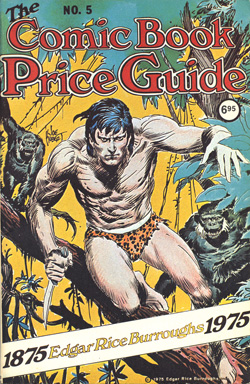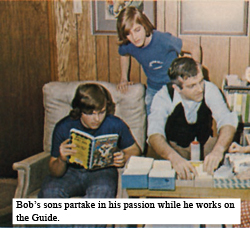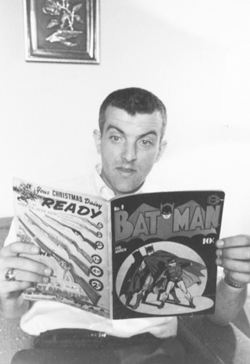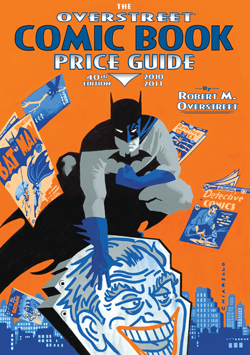Bob Overstreet: His Career and His Future
Feb 22, 2010
Not many people see their passion grow into an industry standard. Bob Overstreet can count himself as a member of this select group. The Overstreet Comic Book Price Guide has provided comic book fans, collectors and dealers with prices, grading information, articles and resource material for 40 years. If you’ve ever opened up the Guide, found a book you owned, and then felt your heartbeat quicken when you’ve looked down the column, you can thank Bob Overstreet.
 Beginnings: First Guides, First Artists, First Love
Beginnings: First Guides, First Artists, First Love
Born in Cleveland, Tennessee, Bob’s passion for collecting began with coins and grew quickly to include comic books, Indian arrowheads, gemstones, fossils, and other items too numerous to list. But comic books were the mainstay in his life.
“My friends and I would buy them right from the newsstand – and as time went on, I began to communicate with other collectors and dealers around the country,” said Bob. “The first real price guide was called "The Rocket’s Blast." When I created the first Overstreet Guide, I bought advertisement space in that guide.”
The first Guide, published in 1970, raised enough money to pay for its own publication – a tradition that has gone unbroken for 40 years. “My father suggested that I sell advertising space in the book. He was a newspaper publisher, so he knew a thing or two about advertising. My first ads were sold to people like Sonny Johnson, Jerry Bales, Ken Mitchell and F.L. Buza, a dealer in Wisconsin.” One of his advertisers, Robert Bell, even supplied complimentary comic bags that Bob used to ship the Guide to customers.
The popularity of the Guide continued to rise over the years, and Overstreet befriended artists who were starting out – but who would become household names among comic book fans.
“I approached Joe Kubert to draw the cover for #5, it was the Tarzan cover. Joe was the first professional artist I ever used. Before that, I used Don Newton who did an excellent Justice Society.” The artist for the first and second editions of the Guide? Bob Overstreet himself.
“All of the artists over the years have been very supportive,” Bob said, “Will Eisner was always there for me, and so was Carl Barks. In fact, Carl drove from California to Tennessee to meet me. He wanted to see the ‘factory’ where the Guide was created.”
Carl Barks, the Duck Master himself, was shocked to see that the production of the book, from beginning to end, was a one-man operation. “I was working full time for a paper company as their statistician and drawing maps of their operations,” said Bob. “I did the Guide in my spare time.”
 Growing The Guide
Growing The Guide
While Overstreet was producing the Guide, he was gathering information from a network of dealers, collectors, and store owners. Out of this group, Overstreet would find a true friend.
“Bruce Hamilton drove out to Tennessee to see me after the first Guide was published. He became one of my top advisors and a very close friend,” he said. “Bruce and I would travel all over the country, taking our vacations together. Bruce was a brilliant strategist who knew how to develop a market, and price books in a manner that wouldn’t shock the market. Instead, those prices allowed it to grow naturally over a period of time.”
Overstreet’s group of collectors began to grow, and an annual meeting was held in the SmokyMountains in Tennessee every year. In addition to the comic book dealers and collectors, Bob also invited advisors and people from other collectible markets – including the watch market.
“We would discuss the markets and price guides – how they developed and how they grew. Our interest was also in the history of other markets – they’re all governed by the same laws of supply and demand.
“After that meeting, I would have a good feel for the market and how many titles were coming in, and who was buying what. The most important factors were how many books existed, the supply in certain geographic areas, and what the prices were.”
The SmokyMountain summits were also a testing ground for possible advisors. As the conversation focused on hot and cold titles, demand and supply, Bob would begin to get a feel for possible additions to the advisor group.
Making the grade today as an advisor is the same as when the Guide first came out. “I look at a person’s reputation: honesty is very important. I met my first advisors in their stores because I wanted to see how they graded comics and how they treated their customers. I didn’t want anyone who was going to lie to me.”
The EC Effect
While super heroes and the Gold and Silver Age are certainly landmarks in his life, Bob remains a passionate fan of the EC Comics and their ground breaking stories and art. He credits the storylines, written for older audiences, as inspiration to look up words and ideas that he discovered in those titles.
The comics were so influential that he and his friends created an initiation ceremony built on the foundation of a Harvey Kurtzman tale.
“You had to walk into this old house at night with one match and make your way up the stairs to the top floor,” he said, “and then when you got up to the room where the former owner had died, you had to light the match in the window. That way, your buddies knew that you had succeeded.”
 Characters That Last and Last
Characters That Last and Last
Supply and demand has always been a key factor in determining prices – along with the characters and issues themselves. Forty years after the first Guide hit the shelves, it’s the popular characters who continue to remain at the top of the list.
“Action Comics #1 remains the hottest – even more popular than it’s ever been. Thanks to the certification system, there’s an inventory of the title and we’re getting an actual count of how many copies exists,” says Bob. “So many people want that title, even in unrestored condition. A Fine copy just sold for $317,000, which is double the Guide price.
Batman, Superman, and Wonder Woman are the DC heavyweights in terms of collectible titles – and their counterparts include Silver Age Spider-Man, Fantastic Four, and The Avengers. When it comes to giving advice on which title to collect, Bob’s mantra is simple: “Stick with the characters who have been around a long time.”
Foresight is always a handy tool in the collector’s chest. Bob would buy stacks of Silver Age comics “right from the newsstand” when they were initially published. “You could just tell that these titles and characters were going to become classics.”
And while the pursuit of key titles has been the passion of many collectors, Overstreet urges all comic book fans to remember this simple rule: read the books!
“It’s amazing how many new events we’re discovering as time goes by,” he says, “I recently bought a run of Detective Comics and in issue #168, the Joker’s origin was explained.” He adds that many of his friends and collectors continue to discover lost information that adds to a character’s history.
 And Now, The Future
And Now, The Future
With 39 issues of the collector’s tome on the shelf, work continues on the landmark issue. Overstreet has seen numerous changes in his profession. Chief among them is the technology used to create the Guide: from typing each page mistake free to layout on computers. The internet has also made its presence felt, making Bob’s job easier in terms of research and gathering information.
As far as plans for the future, Overstreet describes the goal of porting the entire publication into an electronic database. “You could have access to the guide via the internet, and then dial up anything you were interested in finding out,” he said. “From a publishing standpoint, we could create mini-guides based on any subject.”
In addition, the Guide’s 40th publication will be celebrated at the San Diego Comic Con in July. Bob has been named a guest of honor at the show – and is expected to make a special announcement.
“I can’t say what right now, but I think people are going to be happy with what we have to say,” commented Bob.
Whatever the news may be, chances are that it won’t be at the end of a long speech from this humble publisher and former book keeper.
“I’m not about making speeches or standing up in front of a lot of people. But if I can sit behind a table and talk to fans all day about comic books, I don’t have any problem with that.”
John Frizzera didn't know anything about comics, besides Sergeant Rock, until he worked with PREVIEWS Editor Marty Grosser for several years. Now he's a comic book reader whose son loves Spider-Man. John lives in Maryland and his work can be found at www.frizzeraink.com.




